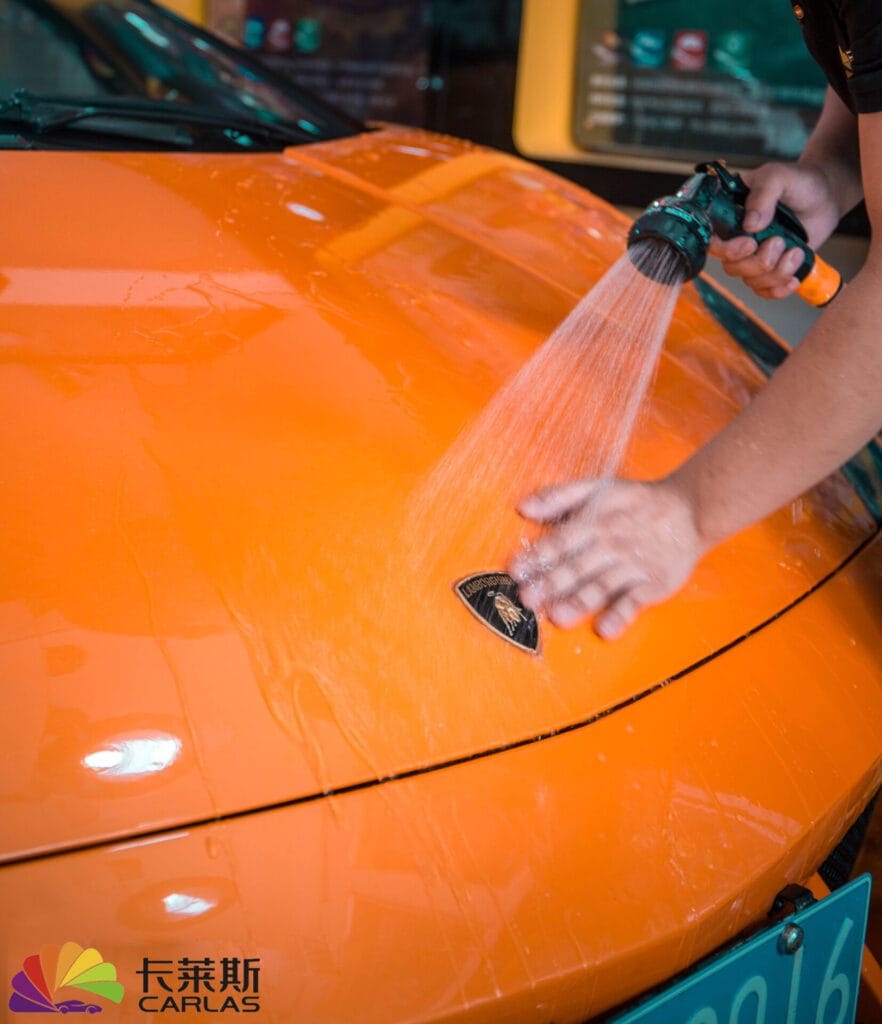Want your paint protection film (PPF) to last 10+ years? Discover essential tips to keep your car’s PPF in top condition—avoid yellowing, edge lifting, and surface damage with proper care and CARLAS-certified techniques.

What Is PPF (Paint Protection Film)?
PPF, or Paint Protection Film, is a transparent, polyurethane-based layer applied to a vehicle’s paint surface. Most high-end versions use TPU (Thermoplastic Polyurethane) and provide:
- Scratch resistance
- UV protection
- Self-healing surface
- Long-lasting gloss and protection
With proper maintenance, quality PPF can protect your vehicle for 5 to 10 years or more.
Why Does PPF Require Maintenance?
Although PPF is engineered to be tough, it still faces exposure to:
- Intense sunlight and UV rays
- Acid rain, dirt, and industrial fallout
- Improper washing methods and chemicals
- Physical wear and environmental stress
Without proper care, even top-tier films may suffer from yellowing, peeling, surface etching, and dullness.
Common Aging Issues and Causes
Yellowing and UV Degradation
Long-term sun exposure can cause films—especially those lacking UV stabilizers—to yellow or become hazy.
Surface Scratches and Contaminant Buildup
Tree sap, bug remains, bird droppings, and road grime can:
- Reduce gloss and clarity
- Hinder self-healing functionality
- Cause discoloration if not cleaned promptly
Edge Lifting and Adhesive Breakdown
This often results from:
- Poor installation (improper heat/stretch/sealing)
- High-pressure washing hitting film edges
- Use of alcohol- or solvent-based chemicals
Key Maintenance Tips for PPF Longevity
Wash Regularly with Neutral Car Shampoo
Clean your vehicle every 7–10 days with:
- pH-neutral, PPF-safe car shampoos
- Soft microfiber towels or wash mitts
- Gentle drying with a plush drying towel to avoid water spots
Avoid Alcohol and Acidic Cleaners
Harsh chemicals can:
- Strip protective top coatings
- Diminish gloss and self-healing capability
- Leave permanent damage on the film surface
Never use household cleaners, dish soap, or bug removers not labeled safe for PPF.
Waxing and Coating: Should You Do It?
Instead of conventional waxes, use:
- PPF-specific detail sprays
- Nano coatings formulated for TPU films
These enhance hydrophobicity and dirt resistance without affecting clarity or breathability.
Handling Common Issues
Self-Healing Minor Scratches
Light surface scratches will often vanish with:
- Direct sunlight exposure
- A heat gun on low setting—sweep gently across the surface
Do not overheat or overapply pressure.
When to Replace or Repair
If your PPF shows:
- Persistent yellowing or cloudiness
- Deep scratches that don’t heal
- Bubbling or edge lifting
…it may be time to replace either the affected panel or the full coverage.
Tips to Extend Overall Film Life
Choose High-Quality TPU Films
Premium films like CARLAS TPU PPF offer:
- Excellent UV blocking
- Long-term elasticity and durability
- Greater resistance to oxidation and stains
These films can last up to 10 years with proper care.
Professional Installation Is Key
The installer’s technique directly affects:
- Seamless edge bonding
- Longevity of adhesion
- Bubble- and wrinkle-free appearance
Always choose certified technicians for best results.
Quarterly Deep Cleaning & Checkups
Every 3 months:
- Clean hard-to-reach edges and wheel wells
- Inspect corners and door handles for lifting
- Apply PPF-safe surface protectants
Why Choose CARLAS PPF and Maintenance Solutions?
CARLAS offers globally trusted TPU PPF that comes with:
- UV-stable, yellowing-resistant formulas
- Matching PPF-safe cleaners and hydrophobic coatings
- Professional training and certified service partners across Asia and beyond
FAQs
Q1: How often should I wash a PPF-wrapped car?
Every 7–10 days is ideal to prevent buildup and staining.
Q2: Can I wax my PPF?
Only with PPF-specific sprays or nano coatings. Avoid traditional waxes.
Q3: Do all scratches self-heal?
Only minor, surface-level marks. Deep cuts may require partial replacement.
Q4: Can I use a pressure washer?
Yes, but keep the nozzle at least 12 inches away and never spray edges directly.
Q5: How do I know when it’s time to replace my PPF?
If you notice yellowing, clouding, edge lifting, or surface peeling, it’s time to replace.
Conclusion: Proper Maintenance = Long-Lasting PPF Protection
PPF is a major investment—and with smart care, it will pay off. By choosing quality products like CARLAS TPU films and following professional maintenance tips, your vehicle can maintain its showroom finish for up to a decade.

